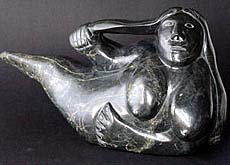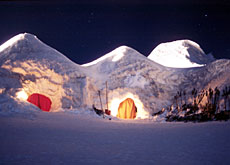Bern displays artistic creativity of the Inuits

A new gallery exhibiting one of the world’s most remarkable private collections of Inuit art has opened in Bern.
It reveals the high level of artistic creativity of indigenous people from the northern polar region who have had little or no formal art education.
The collection was begun 15 years ago when Canadian-born Martha Cerny and her Swiss husband, Peter, bought over 120 undocumented pieces including stone and whalebone sculptures, stone prints and rare batiks.
They subsequently made several visits to northern Canada and Iqaluit in the eastern Arctic and after extensive research managed to identify the creators of 80 per cent of the works, which come from both sides of the Bering Strait.
Compared with other private collections this is impressive. What also makes it unique is that the objects are not only from Canada, Alaska and Greenland, but also from Chukotka in Russia.
Cerny told swissinfo that childhood years in Alaska first exposed her to what she describes as the wonderful work of indigenous people in the far north.
But it was not until much later, when she and her husband read an advertisement in the Zurich newspaper, the “Neue Zürcher Zeitung”, offering Inuit art for sale that the collection was started.
Growing fascination
“We became fascinated,” she said, “and the fascination grew during our visits to the region.”
The Cernys went on to add objects made from walrus tusk and antlers to the collection, as well as carvings, baskets and jewellery.
Visitors to the gallery – who can buy some of the exhibits – are invariably astonished at the high quality of the art on display, which begs the question: why are the Inuits so artistically creative?
“It has a lot to do with their way of life,” said Cerny. “They have to be inventive to survive and couldn’t survive without making use of the material readily available. Their society is one in which nothing is wasted. They hunt to eat but never to excess.
“When an animal is hunted, it’s not just for food. The skin provides clothing and the fat is used for lamps or heating, while the bones are used for shelters or to make runners for sleds.
Nothing wasted
“As you can see,” she added with a nod towards the collection, “the waste products are converted into beautiful works of art.”
Inuit skills are handed down from generation to generation in a society which has developed a natural talent to survive in a region where winter temperatures are well below freezing point.
“They have to be good with their hands to make sleds or harpoons,” said Cerny.
“It follows that they are also skilled at artwork, which in northern Canada now accounts for about 30 per cent of their total income in an area where jobs are scarce.”
As well as using their collection to draw attention to art in the little-known polar region, the Cernys also organise exhibitions elsewhere and give lectures about the Arctic, its people, their culture and nature.
School visits to the gallery are encouraged and cultural events are held there for businesses.
“While the market for Inuit art is well-established in North America,” says Martha Cerny, “its development in Europe and other continents is only just beginning.”
swissinfo, Richard Dawson
Martha and Peter Cerny began their collection of Inuit art 15 years ago.
It includes stone and whalebone sculptures, objects made from walrus tusk and antlers, as well as carvings, baskets, jewellery and rare batiks.
Exhibits come from Canada, Alaska, Greenland and Chukotka in Russia.
The sale of artwork accounts for about 30 per cent of the income of Inuits in northern Canada, an area where jobs are scarce.
The Cernys also organise exhibitions elsewhere and give lectures about the Arctic, its people, their culture and nature.

In compliance with the JTI standards
More: SWI swissinfo.ch certified by the Journalism Trust Initiative

You can find an overview of ongoing debates with our journalists here. Please join us!
If you want to start a conversation about a topic raised in this article or want to report factual errors, email us at english@swissinfo.ch.